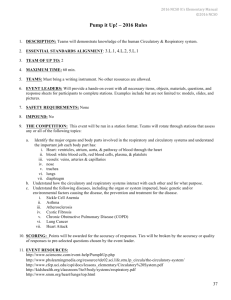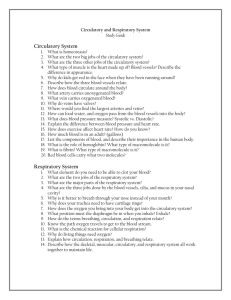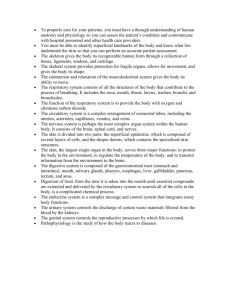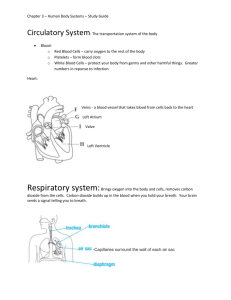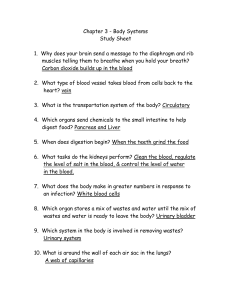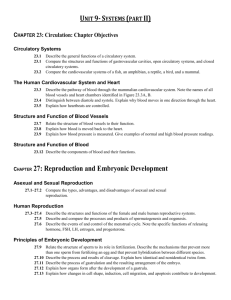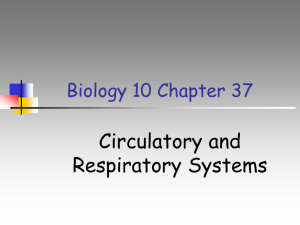Unit 10 - OpenWetWare
advertisement
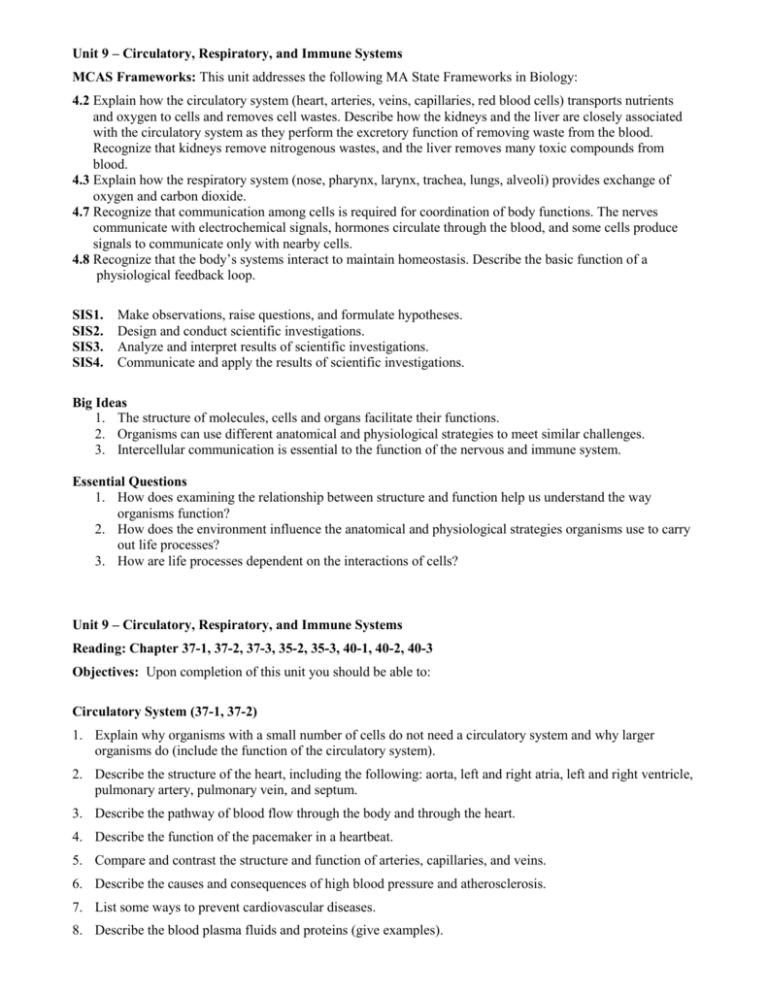
Unit 9 – Circulatory, Respiratory, and Immune Systems MCAS Frameworks: This unit addresses the following MA State Frameworks in Biology: 4.2 Explain how the circulatory system (heart, arteries, veins, capillaries, red blood cells) transports nutrients and oxygen to cells and removes cell wastes. Describe how the kidneys and the liver are closely associated with the circulatory system as they perform the excretory function of removing waste from the blood. Recognize that kidneys remove nitrogenous wastes, and the liver removes many toxic compounds from blood. 4.3 Explain how the respiratory system (nose, pharynx, larynx, trachea, lungs, alveoli) provides exchange of oxygen and carbon dioxide. 4.7 Recognize that communication among cells is required for coordination of body functions. The nerves communicate with electrochemical signals, hormones circulate through the blood, and some cells produce signals to communicate only with nearby cells. 4.8 Recognize that the body’s systems interact to maintain homeostasis. Describe the basic function of a physiological feedback loop. SIS1. SIS2. SIS3. SIS4. Make observations, raise questions, and formulate hypotheses. Design and conduct scientific investigations. Analyze and interpret results of scientific investigations. Communicate and apply the results of scientific investigations. Big Ideas 1. The structure of molecules, cells and organs facilitate their functions. 2. Organisms can use different anatomical and physiological strategies to meet similar challenges. 3. Intercellular communication is essential to the function of the nervous and immune system. Essential Questions 1. How does examining the relationship between structure and function help us understand the way organisms function? 2. How does the environment influence the anatomical and physiological strategies organisms use to carry out life processes? 3. How are life processes dependent on the interactions of cells? Unit 9 – Circulatory, Respiratory, and Immune Systems Reading: Chapter 37-1, 37-2, 37-3, 35-2, 35-3, 40-1, 40-2, 40-3 Objectives: Upon completion of this unit you should be able to: Circulatory System (37-1, 37-2) 1. Explain why organisms with a small number of cells do not need a circulatory system and why larger organisms do (include the function of the circulatory system). 2. Describe the structure of the heart, including the following: aorta, left and right atria, left and right ventricle, pulmonary artery, pulmonary vein, and septum. 3. Describe the pathway of blood flow through the body and through the heart. 4. Describe the function of the pacemaker in a heartbeat. 5. Compare and contrast the structure and function of arteries, capillaries, and veins. 6. Describe the causes and consequences of high blood pressure and atherosclerosis. 7. List some ways to prevent cardiovascular diseases. 8. Describe the blood plasma fluids and proteins (give examples). 9. Compare and contrast the role of red and white blood cells in the body. 10. Describe the structure and function of the lymphatic system. Respiratory System (37-3) 11. Explain the difference between respiration and cellular respiration. 12. Explain the function of the respiratory system. 13. Diagram/describe the structure of the respiratory system, including the following: nasal cavity, pharynx, larynx, trachea, bronchus, bronchioles, lungs, and alveoli. 14. Explain the role of cilia in the respiratory system. 15. Describe the pathway of air in the respiratory system. 16. Relate diffusion and gas exchange in the lungs. 17. Describe the effect of tobacco on the body (specifically its 3 most dangerous substances). 18. Explain the effects of chronic bronchitis, emphysema, and lung cancer. Immune System (40-1, 40-2, 40-3) 19. Explain how microorganisms and viruses cause diseases. 20. Describe the first line of defense. 21. Describe the second line of defense. 22. Explain how humoral immunity is used to fight infection. 23. Explain how cell mediated immunity is used to fight infection. 24. Relate allergies, asthma, immunodeficiency and autoimmune diseases to the immne system. Key Words and Concepts Circulatory System Closed circulatory system Heart Atrium Systemic Circulation Pulmonary Circulation Artery Vein Valve Pacemaker Aorta Capillary Blood Pressure Atherosclerosis Plasma Hemoglobin Red Blood Cell White blood Cell Lymph Respiratory System Pharynx Trachea Larynx Bronchus (pl. bronchi) Alveolus (pl. alveoli) Immune System Disease Pathogen Vector Antigen Antibody Immunity Inflammatory response Immune response Cytotoxic T-cell Helper T-cell Memory T-cell B-cell Macrophage Non-specific defense Specific defense Humoral immunity Cell mediated immunity Vaccination Active immunity Passive immunity Allergy Histamine Asthma Autoimmune Immunodeficiency
